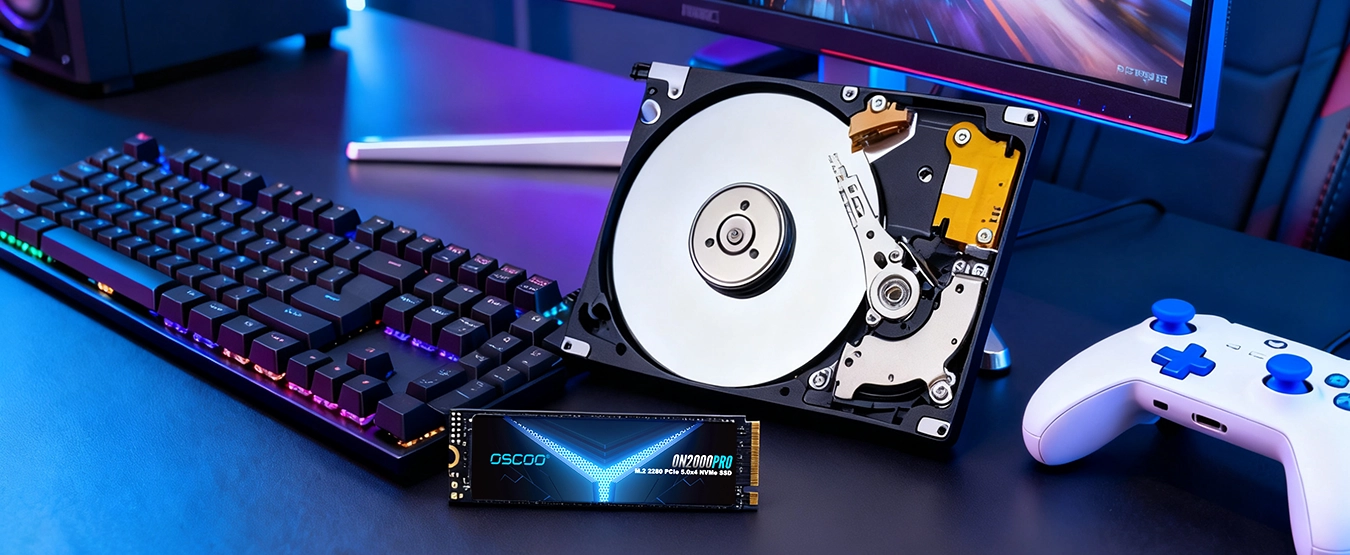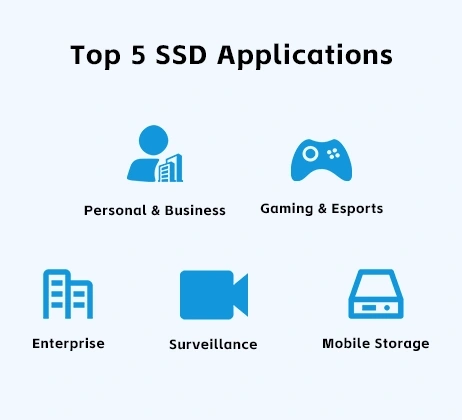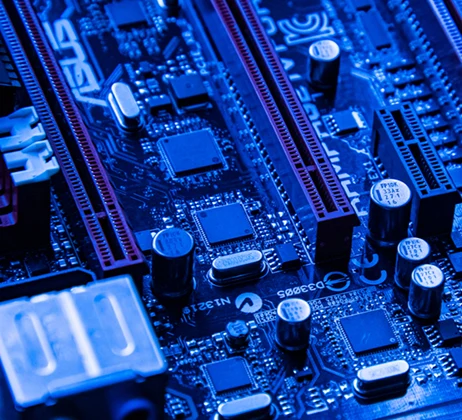In modern gaming, the choice of storage device is far more important than many realize. It’s not just a warehouse for game files; it directly determines how fast games load, how smoothly they run, and the overall quality of your experience. Just like a wide highway ensures smooth traffic flow, a high-performance Solid State Drive (SSD) provides extremely high data transfer speeds for games. Therefore, making a smart choice between SSD and Hard Disk Drive (HDD) is one of the most direct and effective ways to improve your gaming experience. Understanding their differences will help you build a better gaming setup.

Technology Comparison
A Hard Disk Drive (HDD) is an electromechanical device. It stores data on fast-spinning magnetic platters. A physical read/write head moves across these platters to access information, similar to an old record player. This reliance on physical movement means HDDs inevitably have seek times and rotational delays when reading/writing data, which limits their maximum speed. A common 7200 RPM desktop HDD usually struggles to exceed 200MB/s sequential read speeds.
In contrast, a Solid State Drive (SSD) is made entirely of electronic chips. It uses storage chips called NAND flash memory to hold data and a smart controller to manage and access this data. Because there are no moving parts involved—data access happens instantly through electrical signals—SSD read/write speeds can easily be several times, even dozens of times faster than HDDs. This fundamental shift from physical movement to electronic transmission is the core reason for SSD’s revolutionary leap in speed.
SSD's Significant Advantages in Gaming
SSD’s performance benefits aren’t just abstract numbers; they translate directly into real improvements in gaming experience. Let’s look specifically at how SSDs perform in various gaming scenarios.
Extremely Fast Game Loading
The most obvious advantage of an SSD is seen in game loading times. Because SSDs have far greater data reading capabilities than HDDs, they drastically reduce wait times for game startup, loading saves, and switching scenes. A scene that used to take 30 seconds to load might only take around 5 seconds on an SSD. This speed boost lets players focus more on the game itself rather than waiting.
Efficient Game Updates and Installs
Modern games update frequently, and patches can often be tens of gigabytes large. SSDs excel at handling read/write operations and decompression of many small files, making game updates and installations much more efficient. Compared to an HDD which might take half an hour or more to update, an SSD can often shorten this process to under ten minutes, getting you back into the game world faster.
Significantly Reduced Stuttering, Improved Smoothness
During gameplay, SSDs provide a steady, reliable stream of data. This is especially important in open-world games that need to load resources in real-time. When moving quickly, the game engine needs to continuously read new environmental data from the storage device. The SSD’s fast response ensures resource loading keeps up with the game’s pace, effectively preventing stutters or texture pop-in caused by slow data reading.
The Foundation for Open Worlds and Future Tech
As game technology advances, SSDs have become essential hardware for experiencing next-generation content. Technologies like DirectStorage are designed specifically for SSD speeds, enabling more detailed game worlds and faster loading. Choosing an SSD not only improves your current gaming experience but also prepares you for upcoming innovations.
SSD's Limitations for Gaming
Like any tech product, SSDs aren’t perfect. While enjoying their great performance, it’s important to understand their limitations to make a fully informed choice.
Higher Purchase Cost
The biggest disadvantage of SSDs compared to traditional HDDs is the higher price per unit of storage. Although SSD prices have dropped significantly in recent years, an SSD still costs about 2-3 times more than an HDD of the same capacity. This means with the same budget, choosing an SSD usually means accepting less storage space. This is an important factor for gamers who need large storage capacity.
More Difficult Data Recovery
Because SSDs use the TRIM command and wear leveling to manage data storage, recovering lost data is much harder than with HDDs. Traditional data recovery methods often don’t work on SSDs due to their different data storage methods and the fact that delete operations often truly erase data. Therefore, it’s crucial to prioritize data backups when using an SSD. It’s recommended to regularly back up important game saves to the cloud or another storage device.
Theoretical Lifespan Limit
SSD flash memory chips have a limited number of write cycles, usually expressed as TBW (Terabytes Written), meaning the total amount of data that can be written over its lifetime. For most gamers, modern SSD lifespans are sufficient for normal use over 5-10 years, but heavy users should still pay attention to this metric. Game installations and updates involve a lot of data writing, which can accelerate SSD wear. However, it’s important to emphasize that for the vast majority of users, an SSD is very unlikely to fail before other components become obsolete.
Long-Term Storage Reliability
Unlike HDDs, SSDs can experience charge leakage over long periods of complete power loss, potentially leading to data corruption. Although this process usually takes years, it’s a factor to consider for long-term game archives. It’s advisable to regularly back up rarely accessed save data to other media or periodically power on SSDs storing important data.
HDD's Continued Value and Use Cases
HDDs still hold an absolute advantage in cost per gigabyte of storage. Currently, the cost per GB for an HDD is typically only one-third to one-half that of an SSD. This means players can get three times or more storage space for the same budget. For users needing to store large game libraries, video recordings, or other large media files, HDDs provide the most economical large-capacity solution.
Ideal as a Data Warehouse
HDDs are perfectly suited as secondary storage devices, especially for storing games and files that aren’t accessed frequently. Many players choose to install their currently played games on an SSD for best performance while keeping their entire game library on an HDD. When they want to play an older game, they can quickly move it from the HDD to the SSD. This hybrid storage approach strikes a good balance between performance and capacity.
Reliability for Long-Term Data Storage
Compared to SSDs, HDDs offer better stability for long-term data storage in a completely powered-off state. Magnetic storage media doesn’t lose charge over time, making HDDs more suitable for archiving important data. Many users choose HDDs to back up important game saves, creative content, and personal documents, ensuring data remains safe for years or even longer.
Higher Data Recovery Success Rate
In case of data loss, the success rate for recovering data from HDDs is relatively higher. Professional data recovery services have mature techniques for mechanical drives, and there’s a better chance of recovering important data even with physical damage. This makes HDDs the preferred medium for many users storing important digital assets.
Hybrid Storage: The Best Practice Solution
For most gamers, choosing only an SSD or only an HDD often fails to meet both performance and capacity needs. Adopting a hybrid storage solution has become the most practical approach, allowing for a near-perfect storage experience on a reasonable budget.
OS & Frequent Games on SSD
We recommend installing the operating system and your most frequently played games on an SSD. Typically, a 500GB to 1TB SSD is enough for the OS and several large games. This ensures daily use and primary gaming benefit from SSD speeds. It’s important to leave some free space on the SSD—usually at least 10-15%—to help maintain its performance and longevity.
Large Game Library on HDD
For games you don’t play often but want to keep, HDDs provide an ideal large-capacity storage solution. You can keep your entire game library on an HDD and move games to the SSD when you want to play them. Modern platforms like Steam and Epic Games have easy migration tools, making this process very simple. Generally, a 2TB to 4TB HDD will meet most players’ game library storage needs.
Using External Storage Wisely
For console users, external storage offers flexible expansion. For example, the PS5 supports connecting an external SSD or HDD via USB to store and run PS4 games. While performance may be slightly lower than internal storage, it still provides a good experience. For PC players, using an external drive to back up important game saves is also a recommended practice.
By properly configuring a combination of SSD and HDD, players can enjoy the performance leap of SSDs while gaining the large capacity of HDDs. This hybrid approach represents the best balance of price and performance currently available and is the ideal choice for most gamers.
Platform-Specific Advice
Different gaming platforms have their own characteristics regarding storage solutions. Understanding these differences helps players choose what best suits their needs. Whether on PC or console, proper storage configuration can significantly improve the gaming experience.
PC Gaming Storage Solutions
The PC platform offers the most flexible storage choices. Current mainstream SSD interfaces include NVMe and SATA. NVMe SSDs communicate directly with the CPU via PCIe lanes, offering very high transfer speeds—sequential read speeds can exceed 3500MB/s, which is particularly beneficial for games needing fast loading of many resources. SATA SSDs, while slower, still offer around 550MB/s read speeds, far exceeding traditional HDDs, making them a good budget option.
For PC players, it’s recommended to install the OS and frequently played games on an NVMe SSD. If the budget is limited, a smaller capacity NVMe SSD paired with a larger SATA SSD or HDD is a good option. Note that some older motherboards may not support NVMe, so check compatibility before upgrading.
Game Console Storage Solutions
Modern game consoles demand higher storage performance. The PS5 uses a custom high-speed SSD with read speeds up to 5500MB/s, enabling new possibilities for game design. The PS5 supports storage expansion via an M.2 slot, but requires the SSD to meet PCIe 4.0 specs with read speeds not less than 5500MB/s, and it needs a heatsink.
Xbox Series S|X uses a different expansion method with a dedicated expansion card slot. While more expensive, this design ensures full performance compatibility. Xbox also supports connecting an external HDD via USB to run Xbox One and earlier games.
For console players, it’s advised to prioritize official expansion solutions for the best experience and stability, even if the initial cost is higher. External HDDs can be a cost-effective supplement for storing less frequently played games. Understanding each platform’s specifics allows players to choose the best storage configuration based on their needs and budget, enjoying fast loading while managing costs.
Buying Guide: How to Choose the Right Storage Device
Choosing the right storage device requires considering several factors: your gaming habits, budget, and platform compatibility. The right choice not only improves your gaming experience but also ensures long-term value for your investment.
Determine Capacity Based on Need
Choose capacity based on the size of your actual game library. If you mainly play 3-5 regular games, a 1TB SSD is usually sufficient. Since modern large games can often exceed 100GB each, it’s wise to leave extra space. If you have a large library and don’t want to uninstall frequently, consider a 2TB or larger SSD, or an SSD+HDD combo. Remember to leave at least 20% free space for the OS and other apps; this is important for maintaining SSD performance and lifespan.
Understand Key Performance specs
Pay attention to key specs when choosing. Read/Write speeds directly affect load times (NVMe >3000MB/s, SATA ~550MB/s). 4K Random Read/Write speeds are even more important for game performance, showing how well it handles many small files. The endurance rating TBW indicates drive lifespan (higher is better). Also, having DRAM cache significantly improves long-term SSD performance, though it adds some cost.
Choose a Reliable Brand & Check Warranty
Storage devices are crucial for data security, so brand reliability matters. Choosing a well-known brand usually means better quality assurance and customer service. Check the warranty period and terms; most brands offer 3-5 years limited warranty. Reading user reviews and professional reviews can also help understand real-world performance and failure rates. Avoid unusually cheap products from unknown brands, as they may have issues with performance and reliability.
الأسئلة المتداولة
Q: Do games run better on SSD vs HDD?
A: Yes, games run noticeably better on an SSD compared to an HDD. This advantage is most evident in loading times, which an SSD can reduce to a fraction of the HDD’s time. SSDs also provide more stable performance during gameplay, especially in open-world titles, by loading textures and resources continuously at high speed, preventing stutters caused by data read delays. Additionally, game updates and installations are much faster and more efficient.
Q: Do games lag less on SSD?
A: Yes, they do. SSDs significantly reduce stuttering during gameplay. This is mainly because SSDs offer faster data access speeds and more stable data transfer performance. In scenes requiring real-time loading of many game resources—like moving or turning quickly in an open world—SSDs can provide the needed data immediately, avoiding the pauses waiting for the HDD’s mechanical head to find data. SSDs also reduce wait times during scene transitions, providing a smoother experience.
Q: Which drive is better for gaming?
A: It depends on specific needs and scenarios. If you want the best performance, an SSD is undoubtedly the better choice, offering the fastest loading and smoothest gameplay. From a value perspective, a hybrid storage solution is often the most practical. We recommend using an SSD for the OS and frequent games, paired with an HDD for a large game library and media files. For those on a tight budget, start with a mid-sized SSD for your system and games, keeping an existing HDD for storage.
Q: Do games run better on SSD PS5?
A: Yes, PS5 games run significantly better on an SSD. The PS5 is specifically designed around a high-speed SSD, with its custom SSD offering read speeds up to 5500MB/s. This fast storage not only drastically shortens load times but also allows developers to create more detailed and seamless game worlds. Using a compatible SSD for expansion provides an experience identical to the internal storage. Even PS4 games load faster on an SSD.
Q: How to choose the right SSD capacity for gaming?
A: Consider several factors when choosing SSD capacity. If you mainly play 3-5 games, 500GB-1TB is usually enough. For players with large libraries, consider 2TB or more. Remember that modern large games can often be over 100GB each, so leave plenty of space. It’s also recommended to keep at least 15-20% free space to help maintain the SSD’s performance and lifespan. If budget is limited, consider an SSD+HDD combo.
A: How to move games to a new SSD?
Q: Moving games to a new SSD is relatively simple. Platforms like Steam and Epic Games have built-in migration tools. In Steam, you can use the “Storage” settings to manage game installation folders and easily move games between drives. For other platforms, you can often move the game files manually and then relocate the installation directory in the client app. For moving the operating system and installed programs, using professional disk cloning software is recommended to ensure all settings and saves transfer correctly. Always back up important data before migrating, just in case.
For most players, the best choice is a hybrid storage solution combining SSD and HDD: install the operating system and frequently played games on the SSD for top performance, while using an HDD to store a large game library and media files for cost-effective capacity. Budget-conscious players can start by investing in a moderately sized SSD for the system and games, expanding storage later. Most importantly, choose based on your actual gaming habits and needs. There’s no need to blindly go for the largest capacity or pay extra for performance you won’t use. Finding the best balance between performance, capacity, and budget is the smartest approach.




